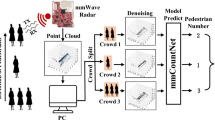Abstract
Pedestrian counting is valuable for business decisions and public safety, but it remains a challenging task in dynamic environments with illumination changes, shadows, background clutter, etc. In this paper, we investigate a novel laser-based bidirectional pedestrian counting approach that addresses these problems effectively. In the proposed method, a laser range scanner is employed in a bird’s eye view to measure the distances between the laser range scanner and obstacles below. Height data of passing pedestrians are accumulated from each scan to generate a height map with noise eliminated. In order to count the number of pedestrians walking in close distances, we apply linear regression to estimate the number of pedestrians in a height cluster using several geometrical features. A variable-sized slide window is then utilized to detect heads in height data. Furthermore, the direction of each pedestrian is determined by voting results of scanning points in the detected head. Experimental results in different environments demonstrate the accuracy and efficiency of our method.











Similar content being viewed by others
References
Arras, K., Grzonka, S., Luber, M., Burgard, W.: Efficient people tracking in laser range data using a multi-hypothesis leg-tracker with adaptive occlusion probabilities. In: IEEE International Conference on Robotics and Automation, pp. 1710–1715. IEEE (2008)
Arras, K., Mozos, O., Burgard, W.: Using boosted features for the detection of people in 2D range data. In: IEEE International Conference on Robotics and Automation, pp. 3402–3407. IEEE (2007)
Bertozzi, M., Broggi, A., Caraffi, C., Rose, M.D., Felisa, M., Vezzoni, G.: Pedestrian detection by means of far-infrared stereo vision. Comput. Vis. Image Underst. 106(2–3), 194–204 (2007)
Bu, F., Greene-Roesel, R.: Estimating pedestrian accident exposure: automated pedestrian counting devices report. Technical report, Institute of Transportation Studies (UCB), UC Berkeley (2007)
Christensen, R.: Plane Answers to Complex Questions: The Theory of Linear Models, 4th edn. Springer, New York (2011)
Cong, Y., Gong, H., Zhu, S.C., Tang, Y.: Real-time people counting using multiple lines. In: IEEE Conference on Computer Vision and Pattern Recognition, pp. 1093–1100. IEEE (2009)
Cui, J., Zha, H., Zhao, H., Shibasaki, R.: Multi-modal tracking of people using laser scanners and video camera. Image Vis. Comput. 26(2), 240–252 (2008)
Dai, C., Zheng, Y., Li, X.: Pedestrian detection and tracking in infrared imagery using shape and appearance. Comput. Vis. Image Underst. 106(2–3), 288–299 (2007)
Fod, A., Howard, A., Mataric, M.: Laser based people tracking. IEEE International Conference on Robotics and Automation, vol. 3, pp. 3024–3029. IEEE (2002)
Fujii, S., Taniguchi, Y., Hasegawa, G., Nakano, H.: Monte Carlo-based Bi-directional pedestrian counting with compound-eye sensor. In: IEEE International Conference on Computer Systems and Industrial Informatics, pp. 1–6. IEEE (2012)
Fujii, S., Taniguchi, Y., Hasegawa, G., Nakano, H.: Monte carlo-based bidirectional pedestrian counting method for compound-eye sensor systems. J. Emerg. Trends Comput. Inf. Sci. 4, 48–57 (2013)
García-Martín, Álvaro, Martínez, J.M.: On collaborative people detection and tracking in complex scenarios. Image Vis. Comput. 30((4–5)), 345–354 (2012)
General Administration of Quality Supervision, I., of People’s Republic of China, Q.: Human Dimensions of Chinese Adults. China Zhijian Publishing House, Beijing (1989)
Jia, B., Feng, W., Zhu, M.: Obstacle detection in single images with deep neural networks. Signal Image Video Process. 10(6), 1033–1040 (2016). doi:10.1007/s11760-015-0855-4
Lee, G.G., Kim, H., Yoon, J.Y., Kim, J.J., Kim, J.J.: Pedestrian counting using an IR line laser. In: IEEE International Conference on Convergence and Hybrid Information Technology, pp. 482–485 (2008)
Lee, J.H., Tsubouchi, T., Yamamoto, K., Egawa, S.: People tracking using a robot in motion with laser range finder. In: IEEE/RSJ International Conference on Intelligent Robots and Systems, pp. 2936–2942. IEEE/RSJ (2006)
Madrigal, F., Hayet, J.B., Lerasle, F.: Improving multiple pedestrians tracking with semantic information. Signal Image Video Process. 8(1), 113–123 (2014)
Miron, A., Besbes, B., Rogozan, A., Ainouz, S., Bensrhair, A.: Intensity self similarity features for pedestrian detection in far-infrared images. In: IEEE Intelligent Vehicles Symposium, pp. 1120–1125. IEEE (2012)
Olmeda, D., de la Escalera, A., Armingol, J.M.: Contrast invariant features for human detection in far infrared images. In: IEEE Intelligent Vehicles Symposium, pp. 117–122. IEEE (2012)
Pang, Y., Yuan, Y., Li, X., Pan, J.: Efficient HOG human detection. Signal Process. 91(4), 773–781 (2011)
Premebida, C., Ludwig, O., Nunes, U.: LIDAR and vision-based pedestrian detection system. J. Field Robot. 26(9), 696–711 (2009)
Shan, D., Zhang, C.: Visual tracking using IPCA and sparse representation. Signal Image Video Process. 9(4), 913–921 (2015)
Son, B.R., Shin, S.C., Kim, J.G., Her, Y.S.: Implementation of the real-time people counting system using wireless sensor networks. Int. J. Multimed. Ubiquitous Eng. 2(3), 63–80 (2007)
Vinay, G.K., Haque, S.M., Babu, R.V., Ramakrishnan, K.R.: Sparse representation-based human detection: a scale-embedded dictionary approach. Signal Image Video Process. 10(3), 585–592 (2016)
Wu, H., Liu, N., Luo, X., Su, J., Chen, L.: Real-time background subtraction-based video surveillance of people by integrating local texture patterns. Signal Image Video Process. 8(4), 665–676 (2014)
Zeng, C., Ma, H.: Robust head-shoulder detection by PCA-based multilevel HOG-LBP detector for people counting. In: IEEE International Conference on Pattern Recognition, pp. 2069–2072. IEEE (2010)
Zhao, H., Shibasaki, R.: A novel system for tracking pedestrians using multiple single-row laser-range scanners. IEEE Trans. Syst. Man Cybern. Part A: Syst. Hum. 35(2), 283–291 (2005)
Zhao, X., He, Z., Zhang, S., Liang, D.: Robust pedestrian detection in thermal infrared imagery using a shape distribution histogram feature and modified sparse representation classification. Pattern Recognit. 48(6), 1947–1960 (2015)
Acknowledgements
This work was supported, in part, by National Natural Science Foundation of China (Nos. 61472455 and 61402120), Natural Science Foundation of Guangdong Province (Nos. 2014A030313154, 2014A030310348), and China Scholarship Council (No. 201506385017).
Author information
Authors and Affiliations
Corresponding author
Rights and permissions
About this article
Cite this article
Niu, Q., Wu, H., Gao, C. et al. Laser-Based Bidirectional Pedestrian Counting via Height Map Guided Regression and Voting. SIViP 11, 897–904 (2017). https://doi.org/10.1007/s11760-016-1037-8
Received:
Revised:
Accepted:
Published:
Issue Date:
DOI: https://doi.org/10.1007/s11760-016-1037-8




